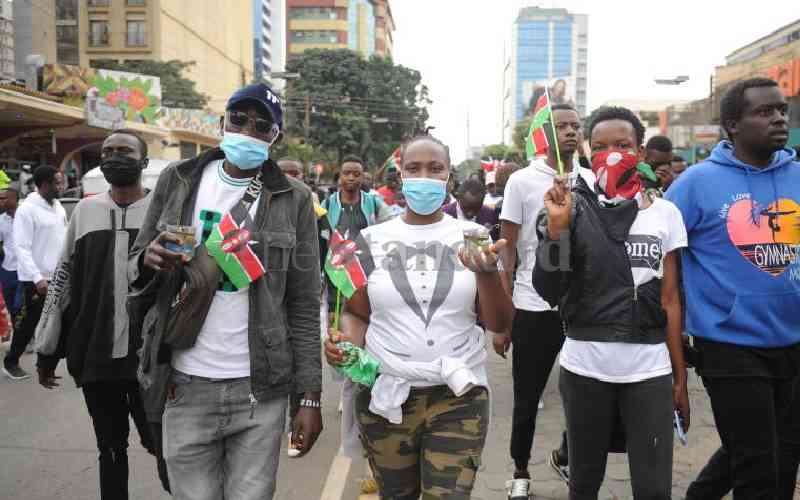NAIROBI: An advertisement in the Press last week sponsored by philanthropic bodies such as the Kenya Paediatric Association, Kenya Medical Association, Gertrude's Hospital Foundation and others brought to the attention of Kenyans the publication of the Traffic (Amendment) Bill 2014.
The Bill sponsored by Laisamis Member of Parliament, Joseph Lekuton, seeks to provide for road safety measures protecting school children and to provide for enforcement mechanisms for speed limits and for connected purposes.
Motorists will be fined a maximum of Sh25,000 if they exceed 30 km/h on any road bordering a school if the Bill is passed by Parliament.
The school roads listed are those leading to nursery, primary and secondary schools. Other proposed measures include creating wide pavements, footpaths, cycle-tracks, roadside barriers, pedestrian crossings, underpasses and footbridges with appropriate signs and markings.
The Bill also makes it a criminal offence for any person involved in the transportation of children to be negligent in preventing the contravention of the regulations.
The timely advertisement gives an opportunity to Kenyans to discuss the proposed law well before it is enacted and it behoves all of us to discuss the well being of the children with greater thought.
Other than protecting the children as envisaged by the Bill, other issues facing children must be addressed as a matter of priority; such as, food, health, security and provision of education facilities for all children.
The Constitution, the Children's Act, United Nations Convention on the Rights of Children (UNCRC), African Charter on the Rights and Welfare of Children (ACRWC), Employment Act and Sexual Offences Act are existing laws that provide for the welfare of children.
Despite the existence of these elaborate laws, the statistical reality relating to children makes for a very sad reading. Kenya's child population is estimated to be about 19 million with an annual growth rate of 2.2 per cent. This amounts to about half of the national population of the country.
In 2002, the government introduced the Free Primary Education (FPE) for all children between the ages of 6 and 13 years. This was in line with the Millennium Development Goals (MDG), one being Universal Primary Education.
The enrolment of children as a result of the FPE in 2002 was estimated at 5.9 million and increased to 8 million in 2007.
However, cultural practices such as FGM and early child marriage in arid and semi-arid areas in the Coast and Northern parts of Kenya resulted in low enrolment for girls. The gender disparity among the school-going children was highest amongst the poor and those in the rural areas.
Shockingly, as of 2012, about one million children were out of school this being the 9th highest rate worldwide.
Good nutrition is crucial to the physical and mental development of a child. In Kenya, one in every 12 children dies before their 5th birthday. Half of these deaths are related to hunger – the affected people mainly being from the nomadic communities living in north-eastern Kenya. In 2013, about 16 per cent of children suffered from acute malnutrition.
The Government introduced feeding programmes in the 1980s which were later discontinued. In 2009, it introduced the Home-Grown School Feeding Program (HGSFP) targeting about 1.2 million children in 3,600 schools throughout Kenya.
Stay informed. Subscribe to our newsletter
In 1998, 15.3 per cent about a quarter of households reported foster children. It has now been estimated in 2010 there were about 2.5 million orphans in Kenya with about a quarter of children under the age of 18 having lost one or both of their parents. Still, the number of orphans in Kenya is rising.
In 2007, the National AIDS Control Council (NACC) reported that 13.5 per cent of children between the ages of 0-18 were orphaned and about 1.4 million of orphans were as a result of the disease.
Kenya has the highest rate of human trafficking in both Central and East Africa. The annual Trafficking in Persons (TIP) report by the US ranks Kenya on the Tier 2 watch list as a result of the Government's failure to increase efforts to combat human trafficking.
As a source, transit, and destination country, Kenya's urban centres such as Nairobi and Mombasa provide both the supply and demand for this industry.
Forced labour is the main form of human trafficking, with nearly half of Kenyan children ages 10-14 years of age being exploited for cheap labour within the country. Kenya's Counter-Trafficking in Persons Act came into effect in October 2012 but the government's efforts remain uncoordinated and lack strong oversight, creating an environment conducive for trafficking.
Out of about 200 child trafficking cases reported to Cradle, the Children Foundation, only 43 were taken to court. Until we get electricity to all schools and also laptops, there are other mundane issues which the national and county governments must address.
In the rural areas, you see hundreds of school children going to and from school bare-footed – indicating the dire poverty prevailing in the country. In some schools, basic facilities in the form of exercise books, pens and pencils are in this day and age still not available.
The MPs and the nation, while discussing the new Traffic (Amendment) Bill, must address all the issues affecting Kenyan children and come up with solutions mainly targeting alleviation of poverty.
 The Standard Group Plc is a
multi-media organization with investments in media platforms spanning newspaper
print operations, television, radio broadcasting, digital and online services. The
Standard Group is recognized as a leading multi-media house in Kenya with a key
influence in matters of national and international interest.
The Standard Group Plc is a
multi-media organization with investments in media platforms spanning newspaper
print operations, television, radio broadcasting, digital and online services. The
Standard Group is recognized as a leading multi-media house in Kenya with a key
influence in matters of national and international interest.
 The Standard Group Plc is a
multi-media organization with investments in media platforms spanning newspaper
print operations, television, radio broadcasting, digital and online services. The
Standard Group is recognized as a leading multi-media house in Kenya with a key
influence in matters of national and international interest.
The Standard Group Plc is a
multi-media organization with investments in media platforms spanning newspaper
print operations, television, radio broadcasting, digital and online services. The
Standard Group is recognized as a leading multi-media house in Kenya with a key
influence in matters of national and international interest.





